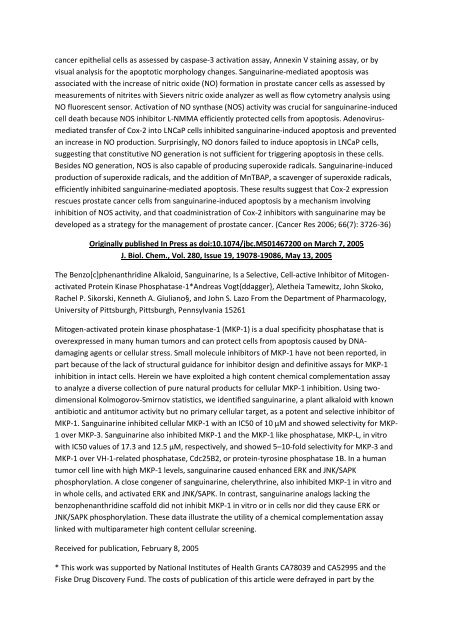Black Salve Alternative Cancer Treatment (1)
Create successful ePaper yourself
Turn your PDF publications into a flip-book with our unique Google optimized e-Paper software.
cancer epithelial cells as assessed by caspase-3 activation assay, Annexin V staining assay, or by<br />
visual analysis for the apoptotic morphology changes. Sanguinarine-mediated apoptosis was<br />
associated with the increase of nitric oxide (NO) formation in prostate cancer cells as assessed by<br />
measurements of nitrites with Sievers nitric oxide analyzer as well as flow cytometry analysis using<br />
NO fluorescent sensor. Activation of NO synthase (NOS) activity was crucial for sanguinarine-induced<br />
cell death because NOS inhibitor L-NMMA efficiently protected cells from apoptosis. Adenovirusmediated<br />
transfer of Cox-2 into LNCaP cells inhibited sanguinarine-induced apoptosis and prevented<br />
an increase in NO production. Surprisingly, NO donors failed to induce apoptosis in LNCaP cells,<br />
suggesting that constitutive NO generation is not sufficient for triggering apoptosis in these cells.<br />
Besides NO generation, NOS is also capable of producing superoxide radicals. Sanguinarine-induced<br />
production of superoxide radicals, and the addition of MnTBAP, a scavenger of superoxide radicals,<br />
efficiently inhibited sanguinarine-mediated apoptosis. These results suggest that Cox-2 expression<br />
rescues prostate cancer cells from sanguinarine-induced apoptosis by a mechanism involving<br />
inhibition of NOS activity, and that coadministration of Cox-2 inhibitors with sanguinarine may be<br />
developed as a strategy for the management of prostate cancer. (<strong>Cancer</strong> Res 2006; 66(7): 3726-36)<br />
Originally published In Press as doi:10.1074/jbc.M501467200 on March 7, 2005<br />
J. Biol. Chem., Vol. 280, Issue 19, 19078-19086, May 13, 2005<br />
The Benzo[c]phenanthridine Alkaloid, Sanguinarine, Is a Selective, Cell-active Inhibitor of Mitogenactivated<br />
Protein Kinase Phosphatase-1*Andreas Vogt{ddagger}, Aletheia Tamewitz, John Skoko,<br />
Rachel P. Sikorski, Kenneth A. Giuliano§, and John S. Lazo From the Department of Pharmacology,<br />
University of Pittsburgh, Pittsburgh, Pennsylvania 15261<br />
Mitogen-activated protein kinase phosphatase-1 (MKP-1) is a dual specificity phosphatase that is<br />
overexpressed in many human tumors and can protect cells from apoptosis caused by DNAdamaging<br />
agents or cellular stress. Small molecule inhibitors of MKP-1 have not been reported, in<br />
part because of the lack of structural guidance for inhibitor design and definitive assays for MKP-1<br />
inhibition in intact cells. Herein we have exploited a high content chemical complementation assay<br />
to analyze a diverse collection of pure natural products for cellular MKP-1 inhibition. Using twodimensional<br />
Kolmogorov-Smirnov statistics, we identified sanguinarine, a plant alkaloid with known<br />
antibiotic and antitumor activity but no primary cellular target, as a potent and selective inhibitor of<br />
MKP-1. Sanguinarine inhibited cellular MKP-1 with an IC50 of 10 µM and showed selectivity for MKP-<br />
1 over MKP-3. Sanguinarine also inhibited MKP-1 and the MKP-1 like phosphatase, MKP-L, in vitro<br />
with IC50 values of 17.3 and 12.5 µM, respectively, and showed 5–10-fold selectivity for MKP-3 and<br />
MKP-1 over VH-1-related phosphatase, Cdc25B2, or protein-tyrosine phosphatase 1B. In a human<br />
tumor cell line with high MKP-1 levels, sanguinarine caused enhanced ERK and JNK/SAPK<br />
phosphorylation. A close congener of sanguinarine, chelerythrine, also inhibited MKP-1 in vitro and<br />
in whole cells, and activated ERK and JNK/SAPK. In contrast, sanguinarine analogs lacking the<br />
benzophenanthridine scaffold did not inhibit MKP-1 in vitro or in cells nor did they cause ERK or<br />
JNK/SAPK phosphorylation. These data illustrate the utility of a chemical complementation assay<br />
linked with multiparameter high content cellular screening.<br />
Received for publication, February 8, 2005<br />
* This work was supported by National Institutes of Health Grants CA78039 and CA52995 and the<br />
Fiske Drug Discovery Fund. The costs of publication of this article were defrayed in part by the



